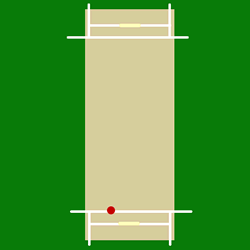
Leg spin is a type of spin bowling in cricket. A leg spinner bowls right-arm with a wrist spin action. The leg spinner's normal delivery causes the ball to spin from right to left when the ball bounces on the pitch. For a right-handed batter, that is away from the leg side, and this is where it gets the name leg break.

Deshabandu Muttiah Muralitharan, also spelt Muralidaran and often referred to as Murali is a Sri Lankan cricket coach, former professional cricketer, businessman and a member of the ICC Cricket Hall of Fame. Averaging over six wickets per Test match, Muralitharan is widely regarded as the most successful and one of the greatest bowlers in the history of the sport. He is the only bowler to take 800 Test wickets and more than 530 One Day International (ODI) wickets. As of September 2023, he has taken more wickets in international cricket than any other bowler. Muralitharan was a part of the Sri Lankan team that won the 1996 Cricket World Cup.

Anil Kumble is an Indian former cricket captain, coach and commentator who played Test and One Day International cricket for his national team over an international career of 18 years. Widely regarded as one of the best leg spin bowlers in Test Cricket History, he took 619 wickets in Test cricket and is the fourth highest wicket taker of all time as of 2022. In 1999 while playing against Pakistan, Kumble dismissed all ten batsmen in a Test match innings, joining England's Jim Laker as the second player to achieve the feat. Unlike his contemporaries, Kumble was not a big turner of the ball, but relied primarily on pace, bounce, and accuracy. He was nicknamed "Apple" and "Jumbo". Kumble was selected as the Cricketer of the Year in 1993 Indian Cricket, and one of the Wisden Cricketers of the Year three years later. Kumble was a member of the Indian team that was one of the joint-winners of the 2002 ICC Champions Trophy, which the title was also shared with Sri Lanka.

Wasim Akram HI is a Pakistani cricket commentator, coach, and former cricketer and captain of the Pakistan national cricket team. Akram is regarded as one of the greatest fast bowlers of all time, as well as one of the greatest left-arm fast bowlers in cricket history. He is often revered as The Sultan of Swing. In October 2013, Wasim Akram was the only Pakistani cricketer to be named in an all-time Test World XI to mark the 150th anniversary of Wisden Cricketers' Almanack. As captain, he led Pakistan to the finals of the 1999 Cricket World Cup, where they lost to Australia by 8 wickets.

Mushtaq Ahmed is a Pakistani cricket coach and former cricketer who currently acts as the spin bowling coach for the Pakistan Cricket Team. A leg break googly bowler, at his peak he was described as being one of the best three wrist-spinners in the world. In an international career that spanned from 1990 until 2003, he claimed 185 wickets in Test cricket and 161 in One Day Internationals. He was at his most prolific internationally between 1995 and 1998, but his most successful years were as a domestic player for Sussex in the early 2000s.
Bishan Singh Bedi; born 25 September 1946) is a former Indian cricketer who was primarily a slow left-arm orthodox bowler. He played Test cricket for India from 1966 to 1979 and formed part of the famous Indian spin quartet. He played a total of 67 Tests and took 266 wickets. He also captained the national side in 22 Test matches. Bedi wore a colourful patka and has always been known for his outspoken and forthright views on cricketing matters. He was awarded the Padma Shri award in 1970 and the C. K. Nayudu Lifetime Achievement Award in 2004.
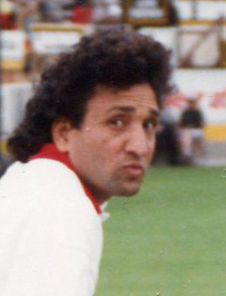
Abdul Qadir Khan SI was an international cricketer who bowled leg spin for Pakistan. Abdul Qadir is widely regarded as a legendary leg spinner from the 1970s and 1980s and was a role model for up and coming leg spinners. Later he was a commentator and Chief Selector of the Pakistan Cricket Board, from which he resigned due to differences of opinion with leading Pakistan cricket administrators.

Hedley Verity was a professional cricketer who played for Yorkshire and England between 1930 and 1939. A slow left-arm orthodox bowler, he took 1,956 wickets in first-class cricket at an average of 14.90 and 144 wickets in 40 Tests at an average of 24.37.
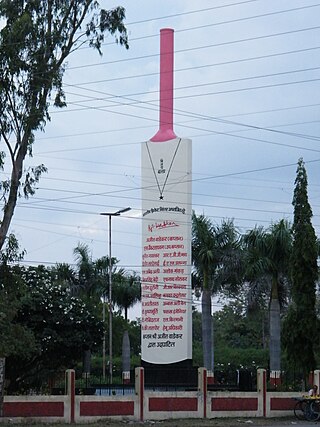
Ajit Laxman Wadekar was an Indian international cricketer who played for the Indian national team between 1966 and 1974. Described as an "aggressive batsman", Wadekar made his first-class debut in 1958, before making his foray into international cricket in 1966. He batted at number three and was considered to be one of the finest slip fielders. Wadekar also captained the Indian cricket team which won series in the West Indies and England in 1971. The Government of India honoured him with the Arjuna Award (1967) and Padmashri (1972), India's fourth highest civilian honour. In 2011, he received the C. K. Nayudu Lifetime Achievement Award, the highest honour Indian board can bestow on a former player.
The Indian spin quartet is the collective name given to the Indian cricket spin bowlers of the 1960s and 1970s: Erapalli Prasanna and Srinivas Venkataraghavan, Bhagwat Chandrasekhar, and Bishen Singh Bedi. Among them, they played 231 Test matches, taking 853 wickets. They were one of the most deadly combinations in world cricket, especially on the dusty subcontinental pitches.
Colonel Hemchandra "Hemu" Ramachandra Adhikari was an Indian cricketer, representing his country as both a player and a coach in a career that spanned three decades. He received the C. K. Nayudu Lifetime Achievement Award in 1998, the highest honour bestowed by BCCI on a former player.
Srinivasaraghavan Venkataraghavan ( is an Indian former cricketer. He captained the Indian cricket team at the first two ICC Cricket World Cups, and later became an umpire on the elite International Cricket Council Test panel. His Test career was one of the longest for any Indian player. He also played for Derbyshire in English county cricket from 1973 to 1975. A qualified engineer and an alumnus of Chennai's famed College of Engineering, Guindy, he is a recipient of the civilian honour of Padma Shri in 2003. He received the C. K. Nayudu Award in 2004, the highest honour bestowed by BCCI on a former player.
Christopher Stewart Martin is a former New Zealand cricketer. A right-arm fast-medium bowler, Martin played provincial cricket for Auckland, having formerly played for the Canterbury Wizards.
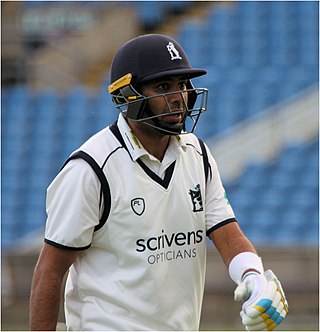
Jeetan Shashi Patel is a former New Zealand international cricketer. A right arm off spin bowler, he plays for Wellington in New Zealand and Warwickshire in England. He is also the spin bowling coach for the England cricket team.
Sonny Ramadhin, CM was a West Indian cricketer, and was a dominant bowler of the 1950s. He was the first of many West Indian cricketers of Indian origin, and was one of the five Wisden Cricketers of the Year in 1951. He is most famous for his performance in the West Indies' 1950 tour of England, which was immortalised in the song "Victory Calypso". He was also well known for his ability to turn the ball both ways and he was also largely known for using three short-legs along with close in fielders on the off-side during his playing days in order to exert more pressure on the batsmen. He was referred to as "a small neat man whose shirt-sleeves were always buttoned at the wrist". He was the last surviving member of the 1950 West Indies team that secured the West Indies' first-ever Test series win in England.
The Indian national cricket team toured England in the 1946 season and played 29 first-class fixtures with 11 wins, 4 defeats and 14 draws. The 1946 season marked a return to normal first-class cricket in England following the end of World War II. The Test series between England and India was the first to be played in England since the West Indies tour in 1939. England won the series 1–0 with two matches drawn, their success largely due to the impact of debutant Alec Bedser who took 22 wickets in his first two Tests.
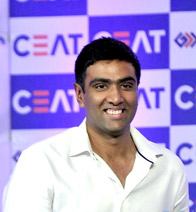
Ravichandran Ashwin is an Indian international cricketer from Chennai, who plays for the India cricket team. In Indian domestic cricket he plays for Tamil Nadu and Rajasthan Royals.
Erapalli Anantharao Srinivas Prasanna is a former Indian cricket player. He was a spin bowler, specialising in off spin and a member of the Indian spin quartet. He is an alumnus of the National Institute of Engineering, Mysore. He received the C. K. Nayudu Lifetime Achievement Award in 2004, the highest honour bestowed by BCCI on a former player.

Kuldeep Yadav is an Indian international cricketer. He is a bowling all-rounder who bowls Left-arm Unorthodox spin bowler is and a capable Lower order batter who plays for India and for Uttar Pradesh in domestic cricket. He was signed by the Delhi Capitals for the Indian Premier League. He has played for the Indian Under-19 cricket team and played in the 2014 Under-19 Cricket World Cup. On 18 December 2019, against the West Indies, he became the first bowler for India to take two hat-tricks in international cricket. On 17 January 2020, in the second ODI against Australia, Yadav became the fastest spin bowler for India, in terms of innings, to take 100 wickets in ODI cricket, in his 58th innings. He helped his national side to win the 2018 Asia Cup as he took the most wickets during the tournament at 10 along with Rashid Khan and Mustafizur Rahman, and being the highest wicket taker for India.